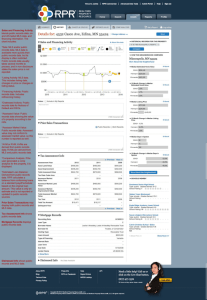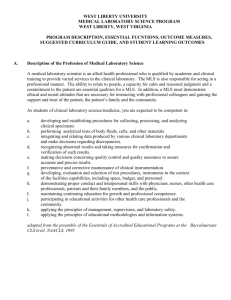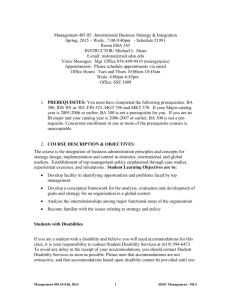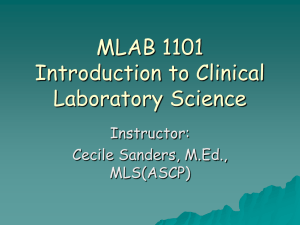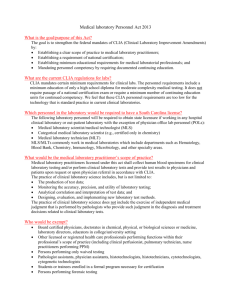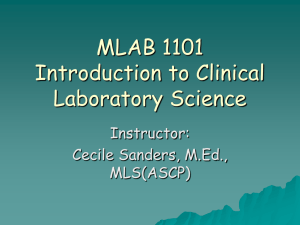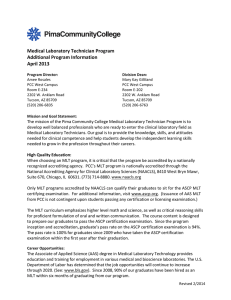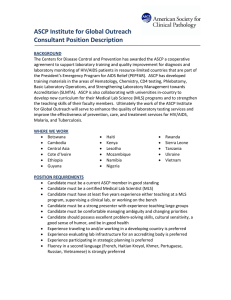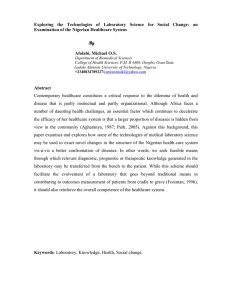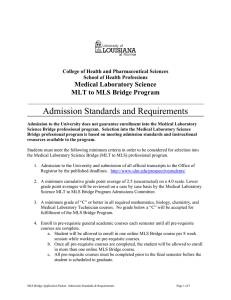Medical montage design template
advertisement
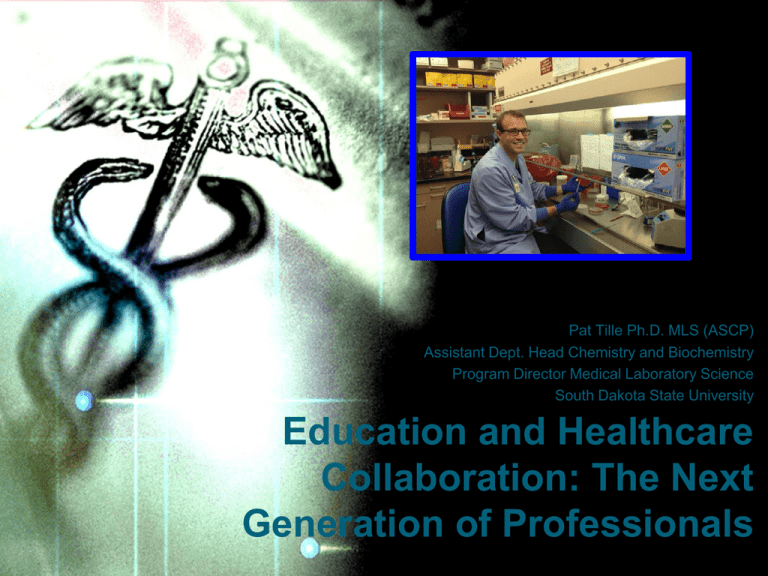
Pat Tille Ph.D. MLS (ASCP) Assistant Dept. Head Chemistry and Biochemistry Program Director Medical Laboratory Science South Dakota State University Education and Healthcare Collaboration: The Next Generation of Professionals Objectives • Review traditional MLS/MLT models and professional training • Explain NAACLS standards and revisions in laboratory science education • List the challenges and opportunities to continue to produce high quality laboratory professionals Laboratory Science Education • Hospital Based Programs • University Based Programs Hospital Based Programs • • • • • • 12 months Lecture and Laboratory simultaneous Trained for laboratory in house Small Labor intensive Cost prohibitive University Based Programs • • • • • • • Historically chemistry degrees Low enrollments Last resort majors Change in pedagogy last 5 years Expensive Not real laboratory experience Length 12 weeks to 9 months Myths • Hospital Based Program students score higher on the ASCP exam than University Based students (Evidence) • Hospital Based students stay in the field longer (Conjecture) • Hospital Based students have more broad training (Conjecture) Content Versus Automation • Large instruments • Hands on theory • Keeping a balance ASCP Board of Certification 2013 2012 ✪ University Programs Overall National SDSU 2011 2010 ✪ 0 100 200 300 400 500 Average of First Time Individual Student Scaled Scores Overall Pass Rate 100% First Time Pass Rate 92% 600 700 SDSU Program Scores Higher than ✪ Hospital and University Based Program National Averages 120 100 80 Professional Students 60 Percent Retention Clinical Retention 40 20 0 2009 2010 2011 2012 2013 Overall Professional Program Retention 83.4% Overall Success in Clinical Practice 96.8%* SDSU Sub-content Areas 800 700 600 500 • IMMUNOHEME: Consistently added improved laboratory exercises; Fall of 2013 added a second semester. • CHEMISTRY: Expanded Instrumentation for implementation this fall. • HEMATOLOGY: Expanded differential counts, disease states and laboratory exercises. Implementing Cella-vision proficiency software this fall. • URINALYSIS: Continued adding disease correlations; Fall 2013 added phase contrast microscopy. 2010 400 2011 2012 300 2013 200 100 0 BBNK CHEM HEM UA SDSU Sub-Content Areas • IMMUNOLOGY; Consistently added more content and techniques including DFA, ANA; 2013 Supporting Course for Advanced Methods: MLS 471 included instrumentation in advanced immunoelectrophoresis and immunofixation • MICROBIOLOGY: Consistently added more content; more variety of organisms, anaerobes, DFA, Acid Fast, Fungal Staining, increased gram stain interpretations, expanding micro II lab this fall, increasing antibiotic susceptibility interpretations. • GENERAL LAB: 2013 Added more application and review of basic concepts; implementation of LIS. For the class of 2014, expanding instrumentation and quality control exercises 700 600 500 2010 400 2011 2012 300 2013 200 100 0 IMMUNO MICRO GEN LAB NAACLS- Myths • • • • Prescriptive Curriculum outlined Rotations, Internships Length New Standards • Competency Based- Outcome Measures • Benchmarks: Measurable, empirical start points? • Must publish one according to NAACLS Guidelines (External certification rates, graduation rates, attrition rates, placement rates, others exit interviews, alumni interviews etc.) • Must be a three year aggregate • Program Director; MLS ASCP Certified • Accreditation: 5 yr Initial, 10 year re-accreditation Reduction in laboratory professionals Education and Patient Care CHALLENGE Reduction in Clinical Training Sites Lengths of Rotations Staff in Clinical Training Sites; qualifications CHALLENGE University Faculty CHALLENGE Create model laboratory professionals Create new models in education OPPORTUNITY MLT MLS DCLS Inter-professional advanced practice Professional Growth Opportunities OPPORTUNITY Doctorate in Clinical Lab Science • • • • Career ladder Epidemiology Pharmacology Patient Assessment Draw in a wider variety of professionals Maintain laboratory testing personnel OPPORTUNITY Center for Collaborative Education • • • • Quality Performance Assessment Aligned to the curriculum Meets or exceeds core standards Deliver Rigorous, culturally responsive and relevant instruction • Leadership Development • Professional Learning Community The future of healthcare In the future will we even go to the hospital? Yes, but we will spend less time as inpatients and more time being monitored remotely by a team of experts. Prevention will be a higher priority. And if you do become ill, a robot may stand in for your doctor. Drugs of the future will target specific cells. Replacement organs will be a reality within years. Gene therapy will be a part of patient care. How and when will we get to this future? The doctor-patient relationship is evolving: Telemedicine means caregivers are remote, but their care isn’t. New Models, Collaborative Content Design and Review ANSWERS? QUESTIONS AND COMMENTS!

